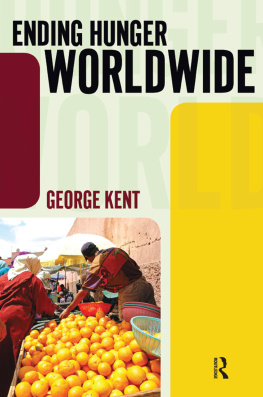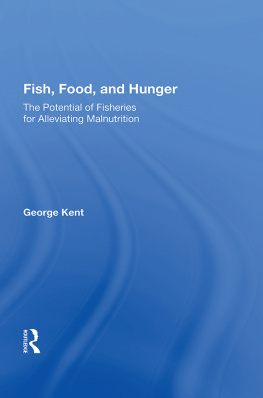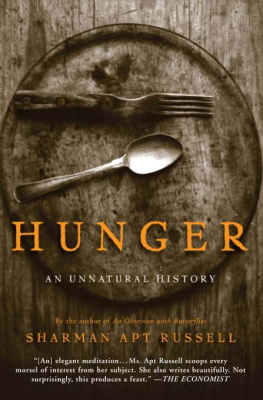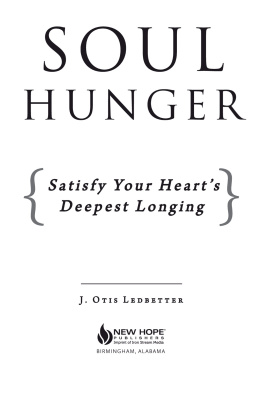First published 2011 by Paradigm Publishers
Published 2016 by Routledge
2 Park Square, Milton Park, Abingdon, Oxon OX14 4RN
711 Third Avenue, New York, NY 10017, USA
Routledge is an imprint of the Taylor & Francis Group, an informa business
Copyright 2011, Taylor & Francis.
All rights reserved. No part of this book may be reprinted or reproduced or utilised in any form or by any electronic, mechanical, or other means, now known or hereafter invented, including photocopying and recording, or in any information storage or retrieval system, without permission in writing from the publishers.
Notice:
Product or corporate names may be trademarks or registered trademarks, and are used only for identification and explanation without intent to infringe.
Library of Congress Cataloging-in-Publication Data
Kent, George, 1939
Ending hunger worldwide / George Kent.
p. cm.
Includes bibliographical references and index.
ISBN 978-1-59451-892-8 (hbk. : alk. paper)
1. HungerPrevention. 2. Food relief. 3. Food-supply. 4. Food industry and trade. I. Title.
HV696.F6K457 2010
363.8dc22
2010019004
ISBN 13: 978-1-59451-892-8 (hbk)
ISBN 13: 978-1-59451-893-5 (pbk)
This book is the result of decades of puzzling over the challenge of global hunger. My explorations began with a chapter on nutrition in The Politics of Pacific Islands Fisheries (Kent 1980). It was fascinating to see how little attention was given to the fact that fish is a food of high nutritive value. In fisheries as in farming, the product is treated mainly as a commodity whose value is in the selling, not in the eating.
Most food products are raised, processed, preserved, packaged, and transported mainly because of the economic benefits they yield, and only secondarily because of their nutritive values. That is good for customers with money, and bad for those without. Whether they go for arugula, coffee, tulips, or ethanol, rich people regularly outbid poor people for farmers services.
As the dominant industrialized food system grows, it squeezes out the smallscale producers on whom many poor people rely for their food supplies. Tyson Foods illustrates the global industrialization of the food system:
Tyson Foods embodied a new mode of agriculture that emerged in Southern states after World War II. Chicken companies were the first to absorb all the local pieces of a small town economy and bring them under one corporate roof. Tyson owned the feed mill, the hatchery and the slaughterhouse. It paid farmers to grow its chicks, using its feed, at a price set by Tyson. This vertically integrated model dominates poultry production nationwide and is expanding into pork and cattle production.
The companys global ambitions are clear:
Now the company plans to duplicate that success in developing nations where a growing middle-class population for the first time can afford to eat meat and visit drive-through windows. As Tyson builds its own slaughterhouses, feed mills and network of contract farmers, it will follow the expanding footprint of fast food chains moving into countries like Brazil and India.
Some of the consequences are predictable:
In India, for example, nearly 65 percent of the population still makes a living off of agriculture and the government restricts the size of farms What would you do with 65 percent of 1.2 billion people? Where would they be employed? I dont think the Tyson-type model would be able to employ that many people. (Leonard 2008)
Under this vision, the growing middle classes of the developing countries are fed by a large corporate mechanism while low-income people are displaced from their meager livelihoods. Much of Tysons profit goes back to Arkansas, just as it does for Walmart. Tyson stockholders surely are pleased with the prospects for expanding the companys global reach. The millions of people who had produced chickens on a small scale would either serve the Tyson-type of system or become unemployed altogether. As contractors or as employees, they would have to accept relatively poor terms of engagement.
I wrote more books and articles that explored the hunger problem, especially as it relates to children. The most recent books prior to this one are Freedom from Want: The Human Right to Adequate Food (Kent 2005) and my edited Global Obligations for the Right to Food (Kent 2008a). Both look upward, focusing on what national governments and international agencies should do about hunger. They center on the human right to adequate food, discussing relevant rights, obligations, and accountability based on international human rights law.
Global Obligations came out just as global food prices peaked in early 2008. This food crisis preceded the broad global economic meltdown of late 2008. The book got little attention, perhaps because people and agencies are more interested in their rights than in their obligations.
On the basis of all this writing and also my work with several global agencies (Food and Agriculture Organization of the United Nations, United Nations Childrens Fund (UNICEF), United Nations System Standing Committee on Nutrition, World Food Programme), I am now convinced that the world as a whole really does not care enough about the hunger problem. The fine rhetoric is not matched by serious commitments of resources and sustained action. The response to the world food crisis has been mainly to quell the food riots that threatened the status quo, and to take care of the middle class.
Good work has been done on reducing malnutrition, but typically the gains have been made in small niches, and in many cases the gains have not been sustained after those who intervened have departed. Global campaigns tend to focus on short-term technical remedies for extreme malnutrition, and do not address the underlying social, political, and economic dimensions.
Where there has been global action it has often been mainly to protect those with power, not to protect the powerless. This thesis has been reinforced by the contrast between the ways in which national and international agencies treat hunger and the ways in which they treated the economic crises that started in 2008. Money cannot be found to deal with the hunger issue in a serious way, but when the moneyed class faced risks, hundreds of billions of dollars became available to rescue them:
This perverse bias in global priorities became palpably clear during the recent global financial crash. People everywhere began to ask: why is it that the governments of the world can summon several trillion dollars to bail out millionaire bankers, and yet no government can afford the moneyjust $30 billion dollars a yearthat would be enough to bail out the worlds hungry? (Parsons 2008)
Similarly, the United Nations High Commissioner for Refugees said:
I am not asking to have the same amount of money for humanitarian action thats being spent, or at least made available, to rescue the international financial system. But at least we should have the same commitment to rescue people that we have to rescue the financial system. (Christie 2008)













